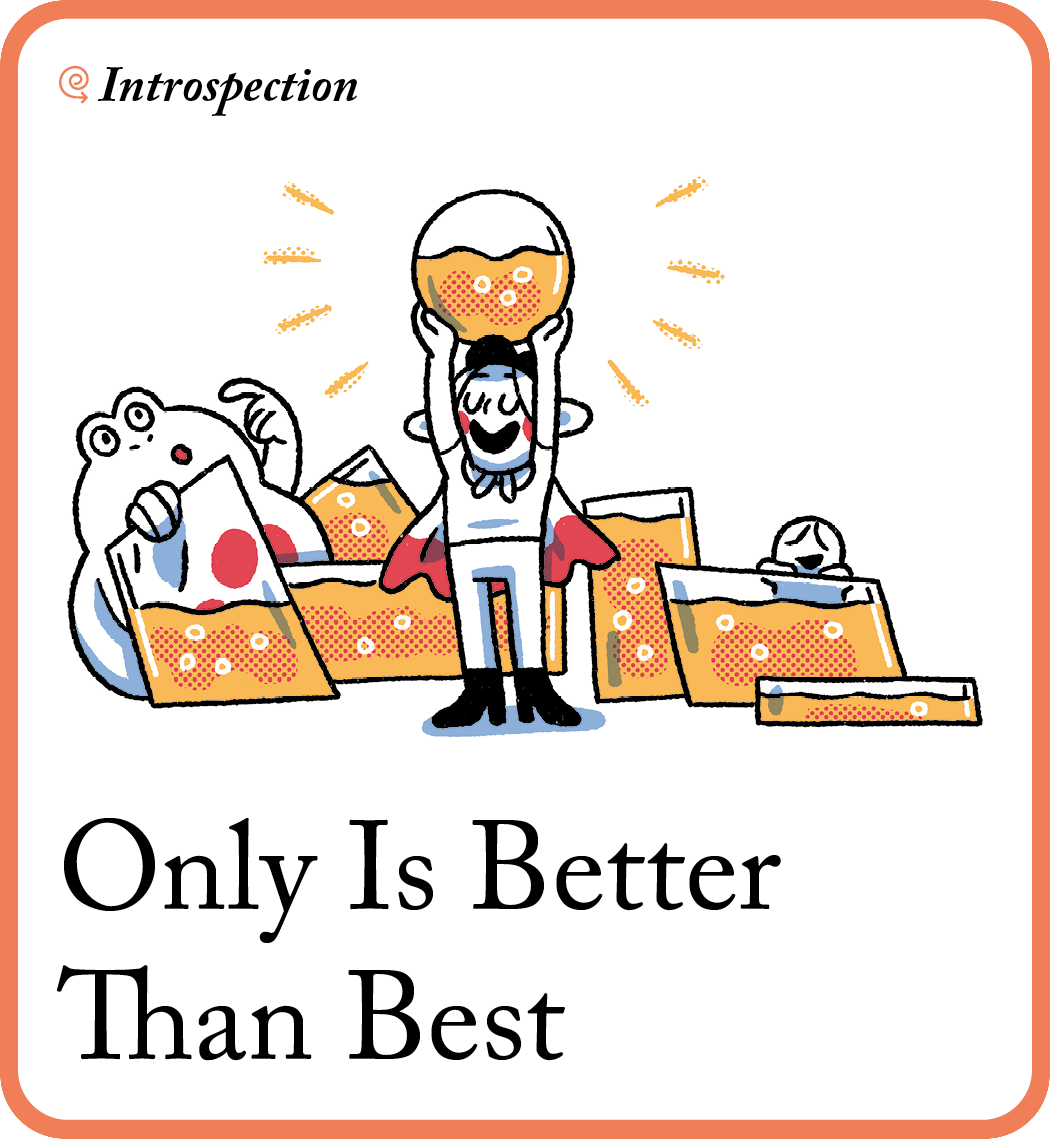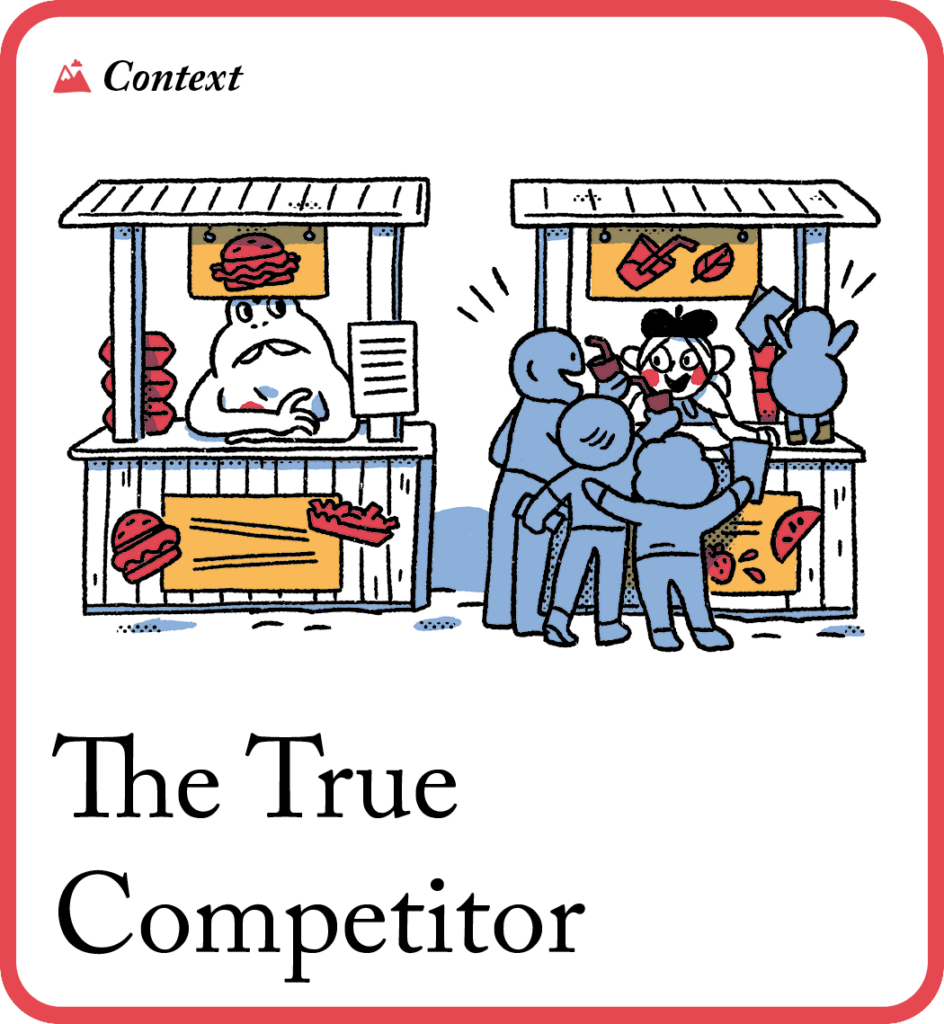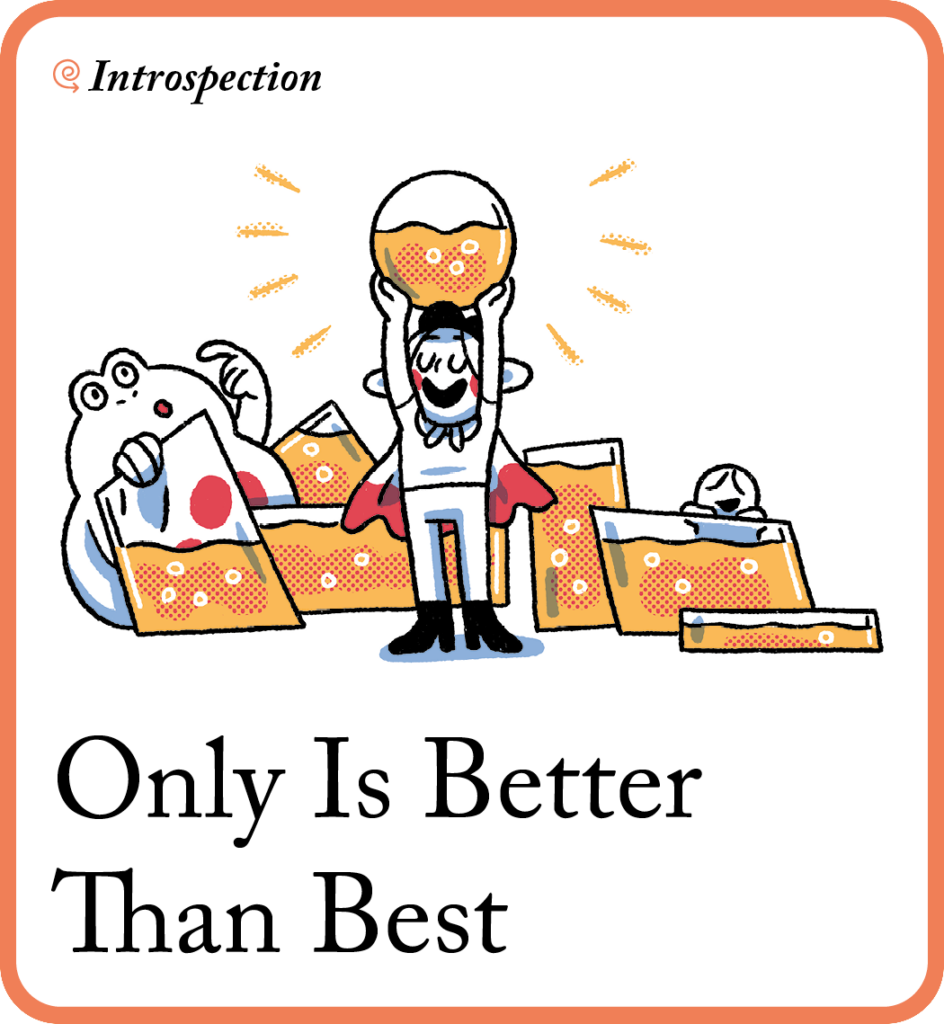Use these tactics
Let’s explore these tactics with an example: Pip’s Cafe
The cafe owners want to continue to develop a unique offering, distinct from their competitors, by enhancing their brand identity and the customer experience in innovative new ways. See below how Pip’s Cafe uses these tactics to solve their problem.
1
Use The True Competitor to discover other brands customers might choose
Use The True Competitor to discover other brands customers might choose

⏱️ Time: 1-1.5 hours
🧠 What’s the goal? Discover the hidden alternatives to your brand so that you understand what you’re really up against.
👀 Why is this important? You don’t compete against brands who look like you or make similar products – you compete against anything consumers might choose instead. Learn where you play.
💡 Tip: this tactic involves being clear about who your actual competitors are, remembering to consider both direct and indirect competitors. An indirect competitor fulfils the same need as your product, but it might be (or appear to be) quite different.
Instructions
-
As a group, or on your own, write down the reasons people might buy from you in the following categories (one per sticky note):
Jobs you do
Basic practical needs your brand/product solves.
Example: Pip’s Cafe: “I come for high-quality, freshly brewed coffee.”Emotional needs you fulfil
Emotional needs your brand/product might solve.
Example: Pip’s Cafe: “I come to relax with my book in a welcoming environment”.The purchase context
The situation in which someone might buy from you.
Example: “I visit when I pass by on my way to work.” -
Gather your answers for each category. Next to each answer, list the most top-of-mind alternatives you can think of.
Example:
Jobs you do: customers come for high-quality, freshly brewed coffee.
Alternative: local/chain coffee stores, like Starbucks.
Emotional needs you fulfil: somewhere welcoming to read a book.
Alternative: the local library, bookstores.
The purchase context: something they pass on their way to work.
Alternative: the gym. -
Shortlist the 4–5 you find the most compelling. These are the alternatives that your brand is truly up against.
Pip’s Cafe is competing against:
Example:- Starbucks in terms of quality coffee
- Libraries as a place to hang out and read
- The gym as a feel-good stop-off on the way to work
⬇️ In the next tactic, use the shortlisted alternatives to your brand with the Only Is Better Than Best tactic.
2
Use Only Is Better Than Best to identify how your brand is unique
Use Only Is Better Than Best to identify how your brand is unique

⏱️ Time: 1 hour
🧠 What’s the goal? Tease out your true competitive advantage by stating what only you do.
👀 Why is this important? You can’t build a great brand by being ‘the best’ – that’s just another way of saying you’re ‘the same’, just a little bit ‘more’. Identify how you’re unique, rather than better, to avoid losing out to brands that are ‘worse’ but have more money or fame. This is where you’ll find the root of your brand.
💡 Tip: have your list of 4-5 competitors that you discovered in the last tactic ready.
Instructions
1. Select the competitors you wish to compare yourself to. These may be direct competitors, or indirect ones you identified in The True Competitor:
- Local coffee shops
- Libraries
- The gym
2. Take the competitors one by one and list the factual differences between your business and theirs.
Tip: these differences must be hard facts – no subjectivity whatsoever.
Good example: ‘Our ketchup is in glass bottles, theirs is in plastic.’
Bad example: ‘Our ketchup tastes good, their ketchup tastes bad.’
Remember to consider:
• Difference in geography
• Difference in customer
• ‘Under the hood’ differences (e.g., manufacturing, company structure, range organisation, etc.).
Other local coffee shops:
- Geography: Pip’s Cafe is centrally located in a residential area, whereas other local coffee shops might be in commercial districts, and chain stores like Starbucks are widespread.
- Customer: Pip’s Cafe caters to a community-focussed clientele, while chain stores often attract a more transient customer base.
- Under the Hood: Pip’s Cafe sources its beans from local, sustainable farms, while chains might use internationally sourced beans.
Libraries:
- Geography: Pip’s Cafe is in a standalone building with a patio, offering a distinct setting compared to libraries, which are typically in institutional buildings.
- Customer: Pip’s Cafe draws patrons looking for a social coffee experience, contrasting with libraries’ solitary reading environment.
- Under the Hood: Pip’s Cafe could add a book swap shelf, offering a unique feature not found in libraries, enhancing its community and cultural appeal.
Gyms:
- Geography: Pip’s Cafe is located in a residential area, easily accessible for those seeking a relaxed setting, unlike gyms in commercial or fitness-focused areas.
- Customer: Pip’s Cafe serves a diverse clientele, differing from gyms’ health-focused patrons.
- Under the Hood: Pip’s Cafe could introduce healthy options like smoothies and protein brownies, appealing to gym-goers and those seeking nutritious alternatives.
⬇️ In the next tactic, take these differences, which might prove to be potential advantages, and feed them into the next tactic Value Mining to see which has the most potential.
3
Use Value Mining to uncover your edge against your competitors
Use Value Mining to uncover your edge against your competitors

⏱️ Time: 2-3 hours
🧠 What’s the goal? Compare your brand directly to a variety of competitors to discover big hidden advantages.
👀 Why is this important? Your brand doesn’t exist in a vacuum. The value it offers is always relative to the other options consumers have. The best place to go looking for that value is in the gap that exists between you and them. This crucial tactic will help you uncover your edge against various competitors.
💡 Tip: remember that seemingly negative differences are just as likely to create value as positive ones.
Instructions
- Use your list of the main factual differences between you and each competitor. Use what you learned in step 2 in the last tactic: Only Is Better Than Best.
- Brainstorm what value might be created for a consumer based on each difference.
Example:
Quality coffee vs. other Local coffee shops/chain coffee stores
Fact: Pip’s Cafe sources its beans from local, sustainable farms.
Value: This emphasises a commitment to sustainability and support for local agriculture, appealing to environmentally conscious consumers.
Cozy atmosphere vs. libraries
Fact: Pip’s Cafe could introduce a book swap shelf.
Value: This addition creates a unique blend of coffee culture and literary exchange, catering to book lovers and those seeking a relaxed reading environment.
Convenient location vs.gyms
Fact: Pip’s Cafe could offer healthy options like smoothies and protein brownies.
Value: This meets the needs of health-conscious customers, particularly gym-goers, offering nutritious choices that complement their fitness routines. - As a group (or with yourself), discuss these ‘value fragments’ and answer the following questions to extract potential value offerings:
Do any value fragments come up frequently?
Can you bundle multiple fragments into an offering?
Are there any themes?
Example:
Frequent value fragment: A focus on community, sustainability, and health appears consistently across offerings.
Bundling fragments: Combining the book swap idea with the cafe’s cozy atmosphere could create a ‘Cafe & Books’ experience. Similarly, introducing healthy food options aligns with the needs of gym-goers and health-focused individuals.
Themes: The overarching themes are sustainability, community engagement, health, and convenience.
Extracting potential value offerings
Sustainable and cultural community hub: Positioning Pip’s Cafe as a centre for both environmental sustainability and cultural engagement, including events like book clubs or local author readings.
Health-focused offerings: Tailoring a menu section for gym-goers and health enthusiasts with items like protein-packed snacks and smoothies, aligning with a healthy lifestyle.
Local collaboration initiatives: Partnering with local gyms for cross-promotional events and with local farms for sourcing ingredients, enhancing the cafe’s commitment to community and health.
⬇️ In the next tactic, take what you have for the unique value your brand offers, and find something your competitor will never do in the next tactic Contrarian Value.
4
Use Contrarian Value to find something your competitor will never do
Use Contrarian Value to find something your competitor will never do

⏱️ Time: 1-2 hours
🧠 What’s the goal? Choose a divine line that all other brands in the category refuse to cross… and cross it.
👀 Why is this important? Great brands aren’t only built on strategies that are different from their competitors – they’re built on strategies that actively disagree with their competitors. Why? Because when you go against something they value, they won’t be able to copy you without undermining themselves. It’s the ultimate chess move…
💡 Tip: remember, you are using your competitors that you discovered using The True Competitor tactic.
Instructions
-
Gather information about what your competitors believe and care about.
Tip: it doesn’t matter whether you agree with them or value these things too.
Example: Chain Coffee Stores (e.g., Starbucks):
Passionate about: Global presence and consistency in their product offerings.
Stated beliefs: Often talk about ethical sourcing and corporate responsibility.
Priorities revealed: Balancing quality with scalability and brand recognition. -
Now you have a handful of beliefs your competitors hold dear, ask the following question:
“What other forms of value would we unlock if we stop doing (or attack) this thing?”
Think about this in terms of arguing against your competitors’ positions. This is how you build up a punchy underpinning for your future brand. Make sure to also keep in mind what you learned about your brand in Value Mining.
Example: What if Pip’s Cafe stopped emphasising artisanal coffee?
Potential unlock: This could free up resources to focus more on creating a community hub, where the coffee is good but the emphasis is more on bringing people together and hosting community events.
⬇️ Now that you have done all four tactics, it is time to check out What next section below.
How do I approach this?
The complete loop: this means short, separate sessions for each of the four tactics sequentially over an extended period of days, or even weeks.
Full-day experience: do it all in one go! Spend the day diving deep and use all four tactics, with lots of breaks in-between.
Some tips
- Don’t lose sight of the goal. What we’re trying to do here is build a business which one, gives people something they want, but also they can’t get anywhere else. So long as you keep that top of mind you’ll move much quicker.
- Let things be a bit random. Don’t feel the need to be overly linear – the big breakthrough could come from any card at any moment.
- If in doubt, write. Write your current thinking in an email, to yourself, to a colleague, to a pal, whoever. It will really help to tidy your thinking and give you extra clarity.
What next?
Congratulations! You have completed a round of How to make your brand truly unique ! You have discovered the alternative brands for consumers, identified how your brand is unique, uncovered your edge against various competitors, and found something your competitor will never do. Your brand will be truly unique.





Thanks for the core back bone of how I need to approach my new business. No longer random approaches for me, now I know how to structure my base brand approach. Thhanks Alex!